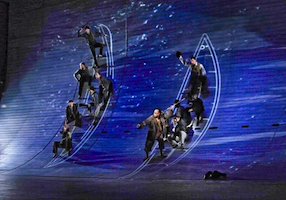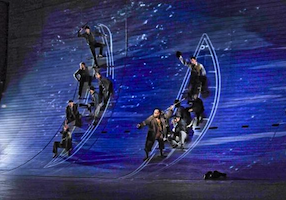
The Dallas Opera wanted something to match the scale of its Texas-sized ambitions for the opening of the Margot and Bill Winspear Opera House in 2010. They got it, and then some, when composer Jake Heggie and librettist Terrence McNally, creators of the 2000 opera Dead Man Walking, proposed an adaptation of Moby-Dick, the intense, sprawling, and altogether monumental 1851 novel by Herman Melville.
In taking on one of the defining and most daunting works of American literature, a sea-voyage tale that spins the peg-legged Captain Ahab’s obsession with a mighty white whale into a churning exploration of revenge, terror, love, community, social class, existential meaning, and the nature of good and evil, the collaborators set out on their own daring spirit quest. Fittingly, it took five co-commissioning opera companies to help pull it off.
Now, trailing a wake of praise from previous productions in Dallas; Adelaide, Australia; Calgary, Canada; and San Diego, Moby-Dick arrives at the San Francisco Opera for eight performances Oct. 10 - Nov. 2 at the War Memorial Opera House. It follows the 2011 premiere of Christopher Theofanidis’ Heart of a Soldier, and is a potentially tonic event for a company that has been in cost-cutting and retrenchment mode. It is also an institutional homecoming for Heggie, who worked in San Francisco Opera’s press department before his career was launched with Dead Man. He composed most of the Melville score in his San Francisco studio.
The Challenge
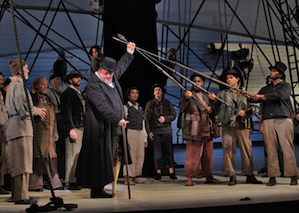
Heggie was as surprised as anyone when “Moby-Dick” came out of McNally’s mouth. “It was the last thing I expected to hear,” said Heggie. “Terrence looked me clear in the eye and said it was the only thing he wanted to do.”
Aside from a few chapters he studied in high school, Heggie had never read the novel and knew only the “very bad” 1956 John Huston film version that starred Gregory Peck. But he saw right away that the story had the elements of grand opera, with overtones of Hamlet, Macbeth, and King Lear. Reading the novel, he discovered something “magnificently poetic and weird,” like “a free improvisation on a jazz theme before there was jazz.” The fact that the story was at once deeply familiar and yet had no iconic film fixed in an audience’s minds, as Gone With the Wind does, was another asset.
Still, the idea was bound to make people swallow hard. When Heggie and McNally first suggested Moby-Dick to director Leonard Foglia, who had staged the world premiere of Heggie’s The End of the Affair, his first thought was of Melville’s famously digressive narrative. “It’s 75 pages of plot and 400 pages of how to tie a knot,” Foglia half-joked. But he quickly signed on. “It was so overwhelming, how could you say no?”
“It was such a joy, I couldn’t wait to get to my studio every day to see what would happen musically with these characters.” – composer Jake Heggie
McNally had to withdraw from the project for health reasons early on. Gene Scheer, who had collaborated with Heggie on other projects, replaced McNally as librettist. Heggie credits McNally for three “amazing ideas” that endured. One was the decision to set the entire opera at sea, excising scenes in Nantucket and elsewhere that would have complicated both the storytelling and the staging. Second was the idea that Ahab should be a heldentenor. And third was the casting of the cabin boy, Pip, as a trouser role for a soprano.
The Making of the Opera
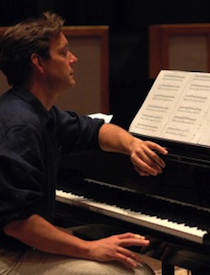
Heggie struggled with the Moby-Dick score initially, discarding more than 50 pages of music. It was only when he jumped ahead to write an aria for Ahab, on Melville’s line “I leave a white and turbid wake,” that the main character bloomed open for him and the writing flowed. “It was such a joy,” he recalled. “I couldn’t wait to get to my studio every day to see what would happen musically with these characters.”
By most accounts, including the composer’s own, Moby-Dick represents a new threshold in his career. He consciously embraced a larger musical universe, linking his celebrated gift for writing for the voice to what he calls “a massive kind of orchestral tone poem.” Critics have heard echoes of Wagner and Verdi in the score.
Heggie’s opera signals “a step towards greater skill and command of the art form,” said San Francisco Opera General Director David Gockley. “It demonstrates an ability to work with a libretto and have it be very cohesive and literate but also provide space for musical expressions that stop time and create indelibly memorable moments.” Acknowledging that Heggie’s “beautiful, audience-friendly music sometimes puts him at odds with critics,” Gockley described a “sophisticated balance of music and lyrical outpouring for an audience that’s paying a lot of money and wants a satisfying experience.”
The Operatic Ahab
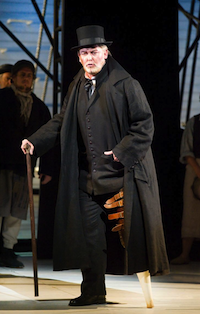
For Jay Hunter Morris, who is playing Ahab in San Francisco (as he did in both Adelaide and San Diego), the part is heaven-sent. “This is my favorite role I’ve ever played,” said the ebullient Texas native. “Listen, I’ve gotten to do some great things” — including Siegfried in San Francisco Opera’s 2011The Ring of the Nibelung. “But this is different. Every tenor in the world is going to want to sing this part.” Morris is a replacement for Ben Heppner, who created Ahab in Dallas and sang it elsewhere but withdrew from the San Francisco production for personal reasons.
Morris, who wrote a paper on Ahab as a Baylor undergraduate, loves the range of single-minded desperation, solitude, frustration, anger, and parental love the character encompasses. He relishes both the joys and the challenges of Heggie’s music, which for long stretches requires Ahab to sing a half step off from the orchestra.
“For tenors it’s all about the high notes,” said Morris, “and Jake knows how to approach them and what vowels to put on them. I have the most thrilling entrance,” he enthused, pointing to “a big bustin’ A-natural on the word infinity.”
Morris let out a long breath of admiration for that note, and then jumped to mention a “truly gorgeous” duet he sings with Starbuck (sung by baritone Morgan Smith). “Jake has a knack for giving us the big moments. He knows how to please.”
“This is my favorite role I’ve ever played. Every tenor in the world is going to want to sing this part.” – tenor Jay Hunter Morris
Like Heggie, Foglia felt the powerful Shakespearean undertow of Moby-Dick. “The conflicts are so huge,” he said. His task, as a director, was to help articulate the characters’ drives, from Ahab’s compulsion to kill the whale to the Quaker Starbuck’s need to get home to his family to Queequeg’s isolation. All of that, Foglia said, had to play off against “the sense of man as a speck afloat in a vast universe.” Robert Brill designed four completely different sets before the visual look of the production, enhanced by video and projections, emerged.
“In other words, it’s very intimate and very big,” said Foglia. That’s the paradox at the heart of Moby-Dick, an unfolding mystery that has captivated readers for over 150 years. Now, in suitably operatic terms, the story begins again.

